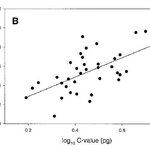Genetics & Molecular Biology

A paper in Cell is reporting the sequence of a Neanderthal mitochondrial DNA genome. Mitochondrial DNA, which you inherit only from your mother, has long been among the most useful DNA regions for tracing your ancestry. In the Neanderthal mitochondrial genome, researchers found, not surprisingly, that the sequence differences are well beyond the range of what we see within human populations, meaning that Neanderthals clearly were a distinct biological sub-species.
The researchers also found that this sequence suggested we split off from Neanderthals about 660,000 years ago (give or take 140,…

Part 1 on The Plausibility of Life
Darwin is famous for convincingly arguing that natural selection can explain why living things have features that are well-matched to the environment they live in. In the popular consciousness, evolution is often thought of as natural selection acting on random mutations to produce the amazing tricks and traits found in the living world. But “random mutation” isn’t quite right - when we describe evolution like this, we pass over a key problem that Darwin was unable to solve, a problem which today is one of the most important questions in biology. This key…

Sleep is regulated by two processes: circadian and homeostatic. Circadian regulation affects the timing of sleep, and the homeostatic mechanism affects the need for sleep.
While scientists and physicians know what happens if you don't get six to eight hours of sleep per night, investigators have long been puzzled about what controls the actual need for sleep. Researchers at the University of Pennsylvania School of Medicine might have an answer, at least in fruit flies. In a recent study of fruit flies, they identified a gene that controls sleep.
Fruit flies typically sleep 12 hours a day.…

The white horse has been an icon for dignity, purity and good guys across various human cultures all over the world but only now has an international team been able to identify the mutation that causes this fascinating trait.
Their analysis shows that white horses carry an identical mutation that can be traced back to a common ancestor that lived thousands of years ago. The study is interesting for medical research since this mutation also enhance the risk for melanoma.
The great majority of white horses carry the dominant mutation 'Greying with age.' A Grey horse is born colored (black,…
“If you want to be happy for the rest of your life you need to make an ugly woman your wife,” or “if your rent is late and you might have to litigate, don’t worry, be happy,” are a few of the ways some popular singers verbalize ways to stay happy. The role that genes and environment play on happiness and the choices a person makes in life have been regularly investigated in studies involving criminals and twins.
If one was to begin exploring genes having an impact on personality at some point it would be necessary to analyze criminal behaviors. In her “Genetic and Environmental Influences on…

Common genetic variations affecting nicotine receptors in the nervous system can significantly increase the chance that European Americans who begin smoking by age 17 will struggle with lifelong nicotine addiction, according to researchers at the University of Utah and their colleagues at University of Wisconsin-Madison.
The study highlights the importance of public health efforts to reduce the number of youth who begin smoking.
These common gene variations - single nucleotide polymorphisms (SNPs) - are changes in a single unit of DNA. SNPs that are linked and inherited together are called a…

One of the many aggravations I encounter when reviewing manuscripts is that some authors greatly overstate the applicability of statistically significant patterns they report. For example, a statistically significant pattern in a small comparison of a few animals may be extrapolated in the discussion to the kingdom at large.
Today I was disappointed to see a paper that is soon to come out in Zoology that does the opposite -- i.e. takes a non-significant relationship in a handful of species and pretends that it challenges the importance of broad relationships that have been considered…

Epigenetic mechanisms are at the heart of developmental biology, orchestrating the formation of many different tissues and organs from a fertilised egg. Almost all cells in an individual have exactly the same genetic material, yet behave very differently depending on which organs they comprise. Epigenetic regulation enables the fine-tuning of our genes and their expression in different places at different times, leading to the amazing complexity we see in humans despite the relatively small number of unique genes.
We all get two copies of every gene, one from our mother and one from our…

In general, domesticated food plants have larger fruits, heads of grain, tubers, etc, because this is one of the characteristics that early hunter-gatherers chose when foraging for food and later planting it.
Domesticated tomatoes can be up to 1000 times larger than their wild relatives but how did they get so big? While tomatoes have long been bred for shape, texture, flavor and nutrient composition, but it has been difficult to study these traits in tomatoes, because many of them are the result of many genes acting together.
These genes are often located in close proximity on chromosomal…

What makes a pointer point, a sheep dog herd, and a retriever retrieve? Why do Yorkshire terriers live longer than Great Danes? And how can a tiny Chihuahua possibly be related to a Great Dane?
Dogs vary in size, shape, color, coat length and behavior more than any other animal and until now, this variance has largely been unexplained. Now, scientists have developed a method to identify the genetic basis for this diversity that may have far-reaching benefits for dogs and their owners.
In the cover story of Genetics, research reveals locations in a dog's DNA that contain genes that…